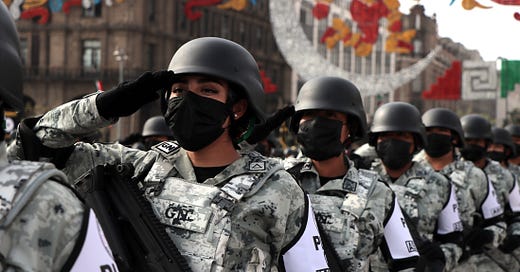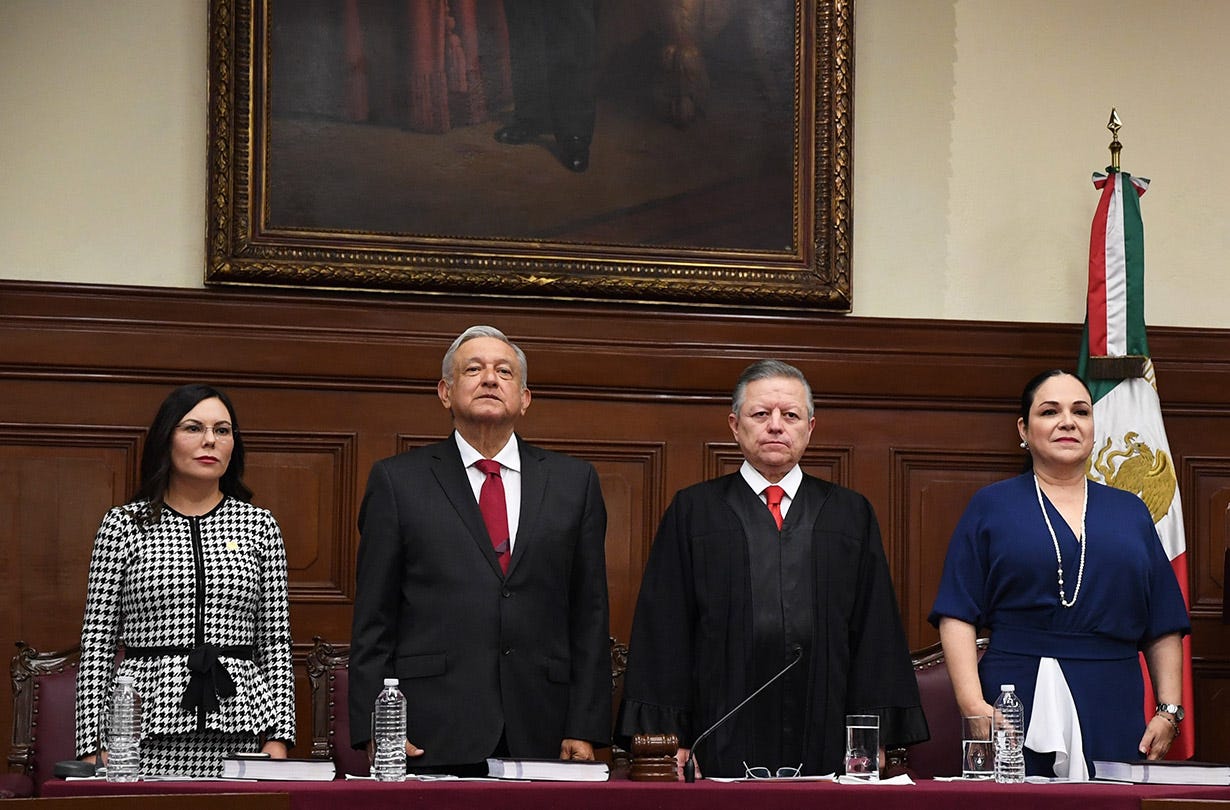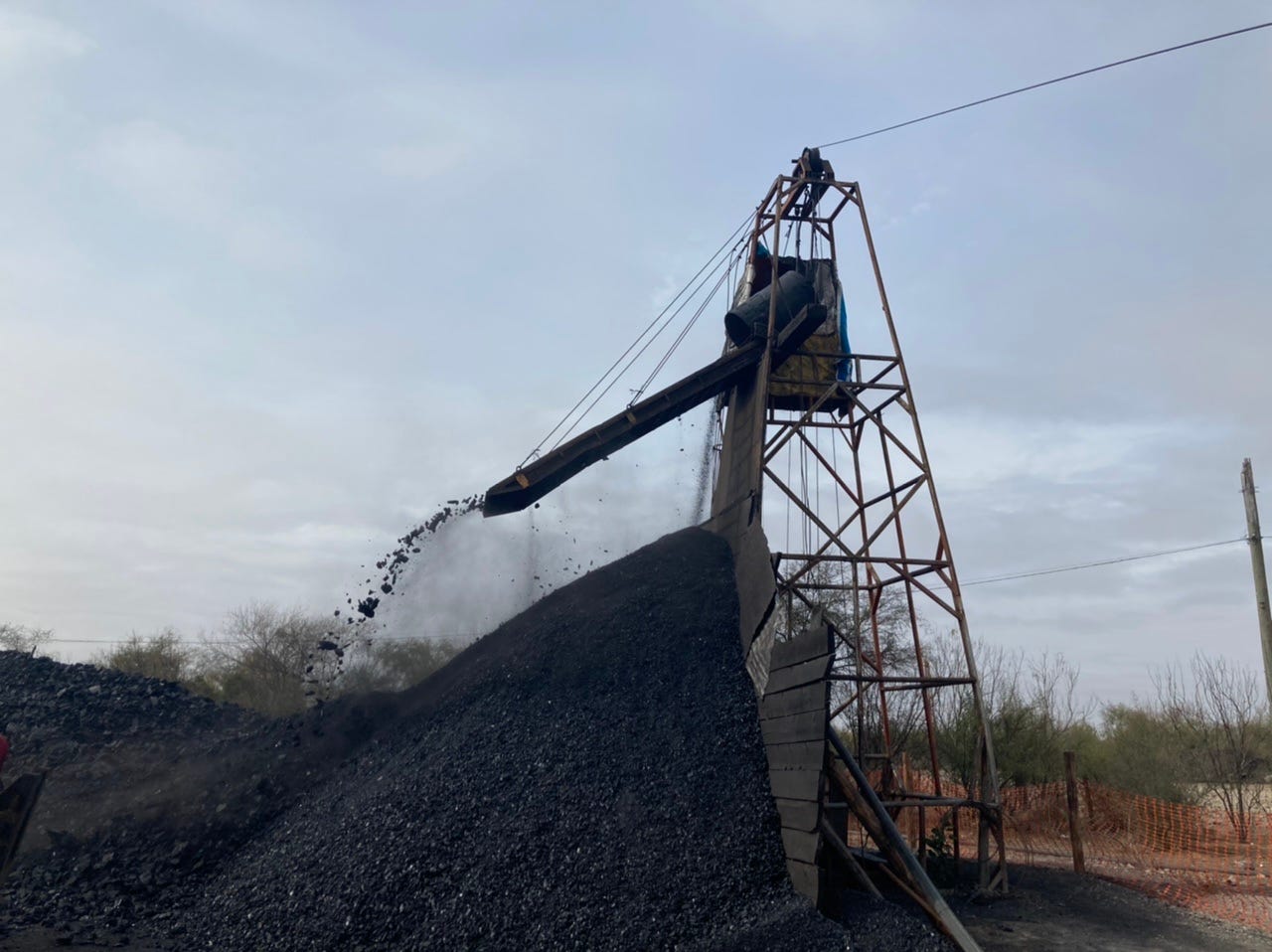AMLO talks tough on crime – except when referring to narcos
Mexico's president is pressuring the high court to declare automatic pre-trial detention constitutional, arguing public safety depends on it. Critics say the practice covers for sloppy investigations
President Andrés Manuel López Obrador and his functionaries have been jawboning the supreme court to uphold the practice of automatic pre-trial detention for a long list of crimes – resorting to law-and-order rhetoric, warning of a “revolving door” of criminals reoffending and even shaming judges for specific cases in which they refused to order suspects held pending trail.
López Obrador – elected as a lefty – his spokesman, Jesús Ramírez Cuevas, and an undersecretary from the Security and Citizen Protection Secretariat, used much of the president’s Friday press conference to pressure the supreme court, which is scheduled Monday to debate pretrial detention.
Along with highlighting cases of suspects not being held, they attacked the media for supposedly failing to previously take up the cause of ending pre-trial detention and only showed an interest in the matter after AMLO won power. (It’s a favourite AMLO trope for casting himself as the victim of unscrupulous opponents.)
“The guardians of justice suddenly want to annul an article of the constitution, something that does not correspond to them. That is very serious. But (they argue) that investigations are not well put together, criminals are given freedom due to influence or corruption. Then these contradictions appear: those who at one time are in favour [of pre-trial detention] are against it.”
AMLO, as the president is known, has taken a tough line on pretrial detention, trotting out functionaries to warn of some 92,000 inmates being held pending trial being released and victims potentially being at risk as their victimizers are sent back out to reoffend. The tough talk on crime and worry for victims contrasts with his policy of never saying a cross word about narcos. He regularly spurns meetings with victims of violence and collectives of mothers searching for their missing loved ones, while stopping to greet El Chapo’s mother in her remote hamlet.
The president’s comments highlighted the main criticism of preventive prison: “That the investigations are not well put together.” In other words, detectives and prosecutors don’t put together proper criminal cases, which would withstand legal scrutiny at trial.
The scenario is best illustrated by the documentary Presento Culpable on the shortcomings of Mexico’s criminal justice system. The prosecutor in the case delivers her arguments via floppy disk, saying cheerfully that is what was required of her. Two detectives come to the courtroom – attached to the prison – where the accused asked them what evidence they had to hold him. “You’re behind bars, aren’t you?” a detective responded. The case eventually overturned on appeal, no thanks to an ace team of lawyers being followed by the documentary filmmakers.
The unfulfilled promise of a landmark judicial reform
Mexico implemented a wide-ranging judicial reform between 2008 and 2016, which introduced oral trials, a presumption of innocence and a promise of speedier outcomes – in a country where people languished for months and years in prison without being sentenced. The author of this newsletter witnessed a case in the northern city of Saltillo, where two bus drivers were accused to selling drugs outside a 7-Eleven store. The case depended on the flimsiest of eye-witness testimony, in which no-one actually saw drugs changing hands. From a 2017 dispatch not previously published:
The courtroom testimony of a bus driver accused of drug dealing in this northern Mexican city sounded distressingly familiar. The accused, clean cut, and wearing a pink shirt, testified in a wood-panelled courtroom of how police supposedly saw him selling meth outside a convenience store. The police, saying they saw 200 pesos change hands, stopped to inquire. Then, he testified, officers planted 10 baggies of drugs. They later punched him in the ribs to extract a confession. Two witnesses corroborated the story, testifying they were all minding their own business. The judge called the testimonies credible. She dismissed the case in less than 90 minutes.
Legal experts said at the time that preparations for the reform – which included USAID-training – focused on getting judges up to speed rather than training investigators and prosecutors in collecting and presenting evidence.
Analysts says the reason for a retention of pretrial detention is the popularity of locking up presumed criminals – in a country where a party running on promises of applying the death penalty for kidnappers proved popular and lynchings occur with disturbing frequency – and politicians preferring not to spend political capital on difficult proposals such as training proper police forces, investigators and prosecutors. As Santiago Aguirre, director of the Jesuit-run Miguel Agustín Pro Juárez Human Rights Centre told this newsletter:
“It’s much easier to reform the law so that more people go to pre-trial detention than invest in prosecutors who do their jobs and are independent and autonomous.”
Corrupt business behind bars
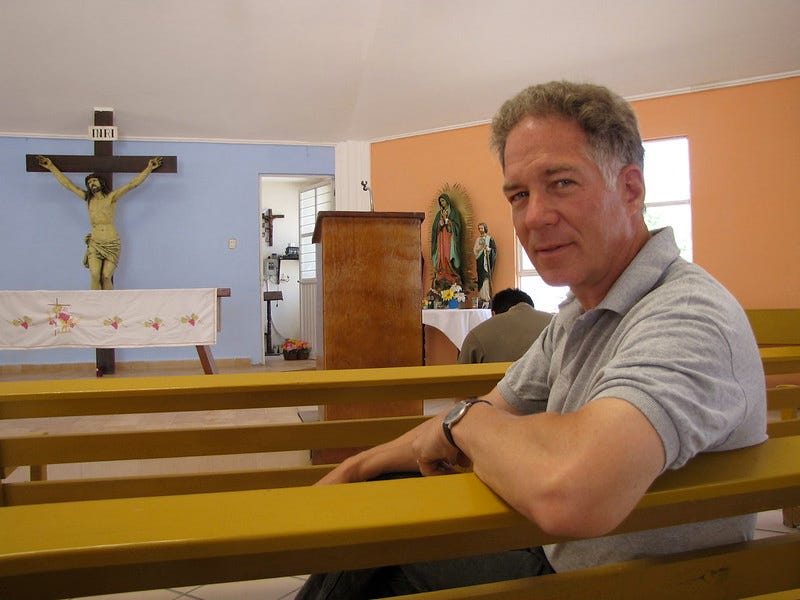
A survey from the state statistics institute (INEGI) estimates 40% of Mexican inmates who have not been sentenced. Bail exists in Mexico, but is hard to obtain – though one of billionaire Carlos Slim’s charitable foundations helps finance bail payments.
A story in the Spanish newspaper El País, citing an INGEI surveys of inmates, found: 46% of inmates shared a cell with at least five people; 13 percent of inmates shared a cell with at least 15 people. Mexican prisons are mostly populated by the poor: 6% of inmates had completed higher education. In court cases, the author, Eunice Rendón wrote, 60% of private lawyers called witnesses in comparison to just 27% of public defenders.
Father Robert Coogan, chaplain at state and federal prisons in Coahuila state, describes a sprawling economy behind bars with families forced to feed their incarcerated loved ones and people being able to purchase less crowded cells and other comforts. He told this newsletter:
“The prison in Saltillo, it was made for 800 people. Right now, it has nearly 2,000 people. So they’ve made a business out of keeping people in prison and they’re raking in money from those families by over-charging them for everything.
“The business is: you over-crowd the cells with new guys so the family will pay you money to put them … two to a cell instead of six to a cell. You have to pay the guards money.”
The real purpose of Mexico’s judicial system
With so many people held without trial, law professor and columnist Ana Laura Magaloni Kerpel wrote a widely shared column in the newspaper Reforma, outlining the uncomfortable reason for failing to eradicate vices such as pre-trial detention. She asked the question, “If it doesn’t establish the truth, what is the criminal justice system for?” She wrote:
“I have always said, ‘The administration of justice in Mexico is a way of exercising power. The links between the executive power and the prosecutor's office (formerly the attorney general’s office) have served and continue to serve for the president to show the vertical nature of power to his opponents and friends alike.”
Magaloni, who AMLO nominated for the supreme court, but was not chosen by the Senate from a slate of three nominees, continued:
“If it happens, it is a powerful brake on the power of the president against his political adversaries. Also, if approved, it would be a mantle of judicial protection for the most vulnerable, who are the main hostages of our penal system.
“(Investigators), with little evidence, can imprison any person for the time that the trial lasts. That is a threat that destroys, little by little, the possibility of opposing.”
AMLO, like his predecessors, has kept his opponents off-balance with an ability to launch investigations into possible cases of corruption. As political analyst Carlos Bravo Regidor said: “AMLO doesn’t have an anti-corruption policy, [but] he’s very good at anti-corruption politics.” Mary Anastasia O’Grady wrote in a 2020 Wall Street Journal column that the AMLO administration has used financial investigations as a means to consolidate power:
“A key tool is the Financial Intelligence Unit (UIF), which derives its power from international commitments to combat money laundering. The unit, which is inside the Treasury (known as Hacienda), is supposed to investigate suspicious financial activity and pass the information to the attorney general. In practice, critics say, it is being used to gain control of institutions that ought to be independent.”
Supreme court case
Mexican presidents lobbying the supreme court is considered normal. The president’s general counsel is known to visit the court frequently to push the executive’s priorities – and is given audiences with the court president.
The court, historically, isn’t known for confronting the president, though it will show its independence on issues not seen as presidential priorities – such as controversial social matters. Mexico’s high court has actively promoted its progressive positions on issues such as marijuana legalization and abortion, which it recently decriminalized – then presenting itself to international audiences as much more progressive than the U.S. Supreme Court on those issues. (This writer has been approached by the court’s public relations team to write a stories on the court president.)

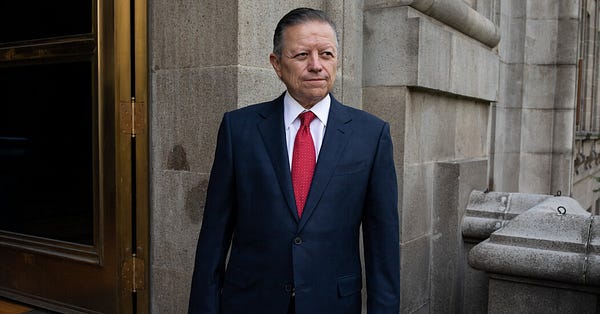
The Supreme Court will argue a case on whether to keep automatic pre-trial detention for a long list of offences – including gasoline theft from pipelines, tax evasion and even burglaries – or mandate if a judge needs to sign off on it. Justice Luis María Aguilar wrote in the case being debated in the court – of which eight of the 11 justices must agree for it to be unconstitutional:
“Pre-trial detention is an exceptional measure and cannot be the general rule. That is, it must be unusual and used only in an unusual way.”
AMLO has argued preventive prison is constitutional based on Article 19 of the Constitution. But legal analysts say it’s not so cut and dry. Law professor Mariana Velasco-Rivera explained in a tweet threat that Mexico approved a reform making human rights treaties part of the country’s constitution, “But the (supreme court) has been struggling to define what exactly that means.”

AMLO regrets his court nominations
As part of his jawboning of the supreme court, AMLO expressed regret over all four of his appointees, who he said had failed to coincide with the so-called “transformation” he has promoted over the past four years. He insisted he wanted free thinkers and independent justices on the court. But he couldn’t hide his distain for their rulings on issues such allowing a plebiscite for bringing former presidents up on criminal charges or changes to electricity industry laws to prioritize public companies over private producers (which were mostly involved with clean energy projects.)
His lament sounded not so dissimilar to U.S. presidents regretting their supreme court appointments – though in Mexico, justices on the high court hold their seats for 15 years. AMLO said of his appointees:
“I was wrong. Once I proposed them, because of the position [on the court] or because they changed, they no long think of a transformational project and in doing justice. They now act more based on legal mechanisms.”
AMLO GIVES MORE POWER, AUTHORITY TO THE ARMY
As promised, AMLO sent a reform to congress on Aug. 31 to place the National Guard under defence secretariat (SEDENA) command, even though the constitution states the security force must have civilian leadership. The lower house of congress wasted no time acting on the proposal, approving it in the pre-dawn hours of Sept. 2. The Senate must now take up the proposal – which does not change the constitution, rather changes secondary laws governing the National Guard and transfers funds from public security secretariat and the navy to SEDENA.
This newsletter wrote on the shortcomings of the National Guard after AMLO first proposed transferring responsibility for it to SEDENA. Still, the legislation sent to congress by the president surprised observers, starting with the attempt a presenting the National Guard as remaining “civilian,” but with military leadership – something necessary, according to the president, to prevent it from becoming corrupted.
“The purpose of this initiative is not to militarise the country or establish authoritarianism, but to care for, with SEDENA guidance, the healthy growth of what should be Mexico’s main public security institution.”
An army takeover
The National Guard started as a mix of military police and Federal Police officers after AMLO took office in late 2018. The military quickly asserted itself and approximately 80% of the National Guard’s 118,000 members are soldiers – with the Federal Police officers being pushed out. One of the transitory laws states the former Federal Police officers will be abandoned, according to Mexicans Against Corruption and Impunity (MCCI), an anti-graft group. The move ensures that the National Guard enjoys “fuero militar” – effectively, immunity from prosecution in civilian courts. MCCI wrote:
“The reality is that fuero militar has allowed the perpetration of multiple, grave violations of human rights. It has left victims unprotected and without access to justice and those responsible without sanctions and in complete impunity.”
Research from the Citizen Security Project at the Iberoamerican University in Mexico City found the military had been preparing itself for the assumption of public security duties through the 2010s. SEDENA and SEMAR (the Navy Secretariat) expanded their military police corps from 6,000 members to 30,000 members and built barracks around the country for them. Samuel Storr, researcher at the Ibero project, told this newsletter:
“The project of the National Guard has always been a project of the army and it’s a project that predates López Obrador by seven years.
“Around 2013, 2014, we can see a very rapid growth after that, year by year, of military police. … It was a plan to cordon off a part of the army so it would be more involved in public security and adapted to that function and receive more training in human rights.”
AMLO has depended on the military through out his presidency, assigning tasks to the army and navy ranging from building and managing airports to operating seaports and the customs service to managing a national park. His partisans previously opposed the use of the military in public security functions and accused former president Felipe Calderón of militarizing the country. Then they won power.
Militarization vs. Militarismo
Deploying the military for public security purposes is nothing new in Mexico. But it’s mushroomed over the past two decades – along with SEDENA’s budget, which has ballooned by 700%, according to the publication Eje Central. Ernesto López Portillo, director of the citizen security program at the Iberoamerican University, told this newsletter:
“[Vicente] Fox has approximately 35,000 soldiers deployed in areas of public security” – and sent them into Nuevo Laredo and seven other cities in 2005. “The total today, including the regular armed forces, is more than 240,000”
Former president Felipe Calderón sent soldiers into Michaocán shortly after taking office in 2006 to stamp out La Familia Michoacana – which proved stubbornly resistant. Peña Nieto continued turning to the military and AMLO oddly came to the conclusion soldiers were somehow more trustworthy than civilian authorities. He argued in his proposal to put the National Guard under army control would prevent it from becoming corrupted.
López Portillo offered a distinction between “militarization” and “militarismo” – with former presidents promoting policies leading to the the former and López Obrador opting for the latter. He said of Mexico’s traditionally non-political military:
“The army seeks to be a political power. Does it seek to be a power that competes politically? I don’t know. What I do know is that, if every day you give resources to the army and take resources away from civilians, then you are going to have the army stronger than what is civilian.”
Underwhelming National Guard performance.


Calderón had been blamed by AMLO supporters for starting the process of militarization. But he also introduced the Federal Police, which began with the aim of becoming a professional force, working with intelligence, technology and modern police practices. His successor, president Enrique Peña Nieto, started to “abandon” the force, according to Francisco Rivas, director of the National Citizen Observatory, while functionaries in his administration “were the architects of dismantling and stealing resources” such as travel expenses. “It opened the door to the corruption of the Federal Police,” he said.
But analysts question the creation of the National Guard, saying no evaluation was performed on the Federal Police prior to AMLO declaring it corrupt and disbanding it. The newsweekly Proceso wrote in a recent cover story:
“Far from what López Obrador boasts, the National Guard does not work.”
Just 14 arrests in 2021 though investigations
The cover story cited a litany of sad statistics on the National Guard. The force arrested only 8,990 persons in 2021. Of those detained, only 14 were through the result of investigations, according to Proceso. Storr, the researcher, said of the National Guard in an interview with the Financial Times:
“It’s mostly an auxiliary force of armed men, who can be deployed alongside municipal police, state police, but which is not really capable of providing the role of municipal police, which has contact with the community, of state police, ministerial police [detectives], which is involved in investigations.”
According to Proceso, the National Guard established a 500-member “Special Reaction and Intervention Force” (FERI) in August. But the force replaced units discarded along with the Federal Police, according to Proceso, which reported:
“National Guard commanders took almost four years to create the FERI, which already existed in the federal forces and Gendarmerie divisions of the extinct Federal Police and were even certified in Israel, the United States and Great Britain.
“That human capital discarded by López Obrador consisted of select sharpshooters, experts in tactical medicine, paratroopers, high-impact air operators, specialists in underwater operations, air infiltration, securing clandestine laboratories and search, identification and neutralization of improvised explosive devices.”
DAUGHTER OF MICHOACÁN MAYOR BUSTED WITH MONEY, GUNS IN LAREDO, TEXAS





The daughter of a MORENA party mayor from the state of Michoacán was busted by U.S. Customs and Border Protection (CBP) while transporting nearly $250,000 in U.S. cash and two handguns at the Juárez-Lincoln bridge between Laredo, Texas, and Nuevo Laredo, Mexico.
Yeishi Moriya Villaseñor, 28, was driving a Mexico-bound Volkswagen Jetta (some reports say she was driving a 2022 Volkswagen Passat) on Aug. 24, when she was singled out for secondary inspection. “CBP officers discovered a total of $248,531 in unreported currency, a Colt 1911 .45-caliber handgun and a Glock 9mm handgun within the vehicle,” according to a CPB statement. Villaseñor was taken into custody by Webb Country Sheriff’s deputies on state currency and weapons charges.
The bust made headlines in Mexico as Moriya’s father is mayor of a municipality in a state with a long history of nacro-infested municipal governments. The MORENA state governor told Mexican media he ordered state officials to intervene on Moriya’s behalf, though it’s uncertain what actions were taken.
Moriya was released after paying $5,000 bail.
Local and Mexican media, citing court documents, report Moriya was contacted in Michoacán by a person named “Eduardo,” an acquaintance she had not seen for two years. He asked her to transport money back to Michoacán. Moriya subsequently travelled with her boyfriend and two children to Dallas to retrieve funds from an address, which was texted to her upon arriving. The Laredo Morning Times reported:
“She was told to report to that location where she was greeted by Eduardo and three other males. She was told to go get something to eat and leave her vehicle behind.
“When she returned, Eduardo told her that her car was ready and gave her $3,000 for transporting the money. An additional $3,000 was given to her for another person in Tacambaro, Michoacán.”
Money was discovered on Moriya’s person and stuffed into the car panels. She said that she didn’t declare the money on her person because she didn’t want to pay taxes.
WORTH READING
Mexico called off rescue efforts for 10 men trapped in an artisan coal mine in Coahuila state – the latest tragedy in a region rife with industrial accidents and few oversights. The Carbonifera region, some 70 miles south of Eagle Pass, Texas, had been suffering as the Peña Nieto administration approved an energy reform to encourage investments in renewables and also gas-fired plants – while mothballing the big coal-fired plant in Nava, near the Texas border.
But López Obrador has bet big on coal, which fits his vision of energy “sovereignty” with government-owned power plants – like the coal-fired plant – providing electricity, even if it’s not especially economical. His populist plan revived the Coahuila coal country, but at a cost: he promised to purchase from small, artisanal mines, which are often death traps. The Associated Press quoted a government official, who noted:
“We had to have the mindset of favouring the smallest (producers) because we had to make their economic conditions more equal. Because as he (the president) has said, one of this country’s main failings is inequality.”

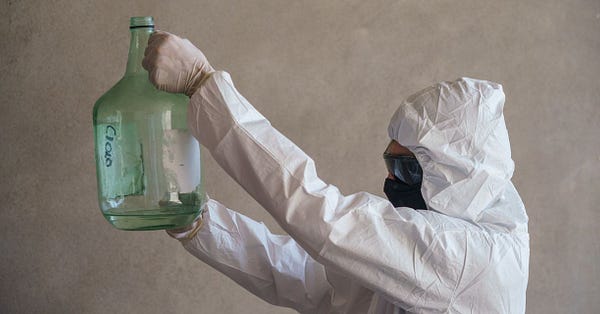
“With business savvy and growing power in Mexico, the Sinaloa and rival Jalisco cartels dominate the market for supplying fentanyl to the U.S. They cornered the market after China cracked down on fentanyl production several years ago and are now churning out bootleg versions of the highly potent synthetic opioid that, in its legal form, is used under prescription to treat severe pain.
”Fentanyl’s inexpensive, easy-to-replicate formula has boosted its appeal to criminal networks. It is also fueling an overdose crisis that claimed more than 108,000 lives in the U.S. last year, a record.”

